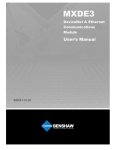Download USER`S MANUAL - Automatisation JRT
Transcript
USER’S MANUAL
JLL-2000 AN
HYDRAULIC
ELEVATOR CONTROLLER
CANBUS PROCESSOR
JLL-2000 SERIES
CODE B44-07 AND CODE B44-07/10
VERSION
JLL-2000_CAN_6011_A_07-10-1.5
TABLE OF CONTENT
1.
LCD USE (JRT-LCD): ............................................................................................................................................................ 1-1
1.1. KEYBOARD: ........................................................................................................................................................................ 1-1
1.2. MENUS: .............................................................................................................................................................................. 1-2
1.2.1. Monitoring menu: ................................................................................................................................................. 1-3
1.2.2. Register Access menu: .......................................................................................................................................... 1-4
1.2.3. Active faults list menu:.......................................................................................................................................... 1-6
1.2.4. Construction mode menu: ..................................................................................................................................... 1-7
1.2.5. Elevator options menu: ......................................................................................................................................... 1-7
1.2.6. Password menu: ................................................................................................................................................... 1-9
2.
USE OF THE PROGRAMMING CONSOLE (PRO01 OU PRO27): ................................................................................. 2-1
3.
TEMPORARY START-UP: ................................................................................................................................................... 3-1
4.
FINAL START-UP: ................................................................................................................................................................. 4-1
5.
CONTROLLER TYPE: .......................................................................................................................................................... 5-1
6.
OPERATION PRINCIPLE FOR CAR ZONING AND LEVELLING: ............................................................................. 6-1
6.1. WITH A STANDARD TAPE SELECTOR: (IP8300 W6 LULA): ................................................................................................ 6-1
6.1.1. Installation of the standard tape ........................................................................................................................... 6-1
6.1.2. End of travel limit switches installation: .............................................................................................................. 6-4
6.1.3. Hoistway access and travel adjustment switches: ................................................................................................ 6-4
7.
TERMINAL SPEED REDUCING DEVICE FOR ELEVATOR GREATER THAN 50’/MIN: ...................................... 7-6
8.
INTERNAL FUNCTIONS AND CONTROLLER CONFIGURATION: .......................................................................... 8-1
8.1. MODIFYING THE DM WITH THE LCD: ................................................................................................................................ 8-1
8.2. MODIFYING THE OPTION WITH THE LCD ......................................................................................................................... 8-1
8.2.1. Motor Protections:................................................................................................................................................ 8-2
8.2.2. Start & Stop fine tuning: ....................................................................................................................................... 8-2
8.2.3. Brake timers & Protections: ................................................................................................................................. 8-2
8.2.4. Motor control pumps, valves: ............................................................................................................................... 8-2
8.2.5. Encoder/Perforated tape: ..................................................................................................................................... 8-3
8.2.6. Door timers & options: ......................................................................................................................................... 8-3
8.2.7. Parking level & timers: ........................................................................................................................................ 8-4
8.2.8. Car calls options: ................................................................................................................................................. 8-4
8.2.9. Gong/Buzzer PI & voice: ...................................................................................................................................... 8-5
8.2.10. Emergency recall (Fire): ...................................................................................................................................... 8-6
8.2.11. Emergency power: ................................................................................................................................................ 8-6
8.2.12. Hydraulic cylinder reset sequence: ...................................................................................................................... 8-7
8.2.13. Blue code/Free car sequence:............................................................................................................................... 8-7
8.2.14. Other Parameters: ................................................................................................................................................ 8-7
9.
SYMBOLS LISTING: ............................................................................................................................................................. 9-8
10. MAINTENANCE: .................................................................................................................................................................. 10-1
10.1. ALARMS AND FAULTS:...................................................................................................................................................... 10-1
10.1.1. Alarms and status list: ........................................................................................................................................ 10-1
10.1.2. Automatic erasing of the alarms: ........................................................................................................................ 10-1
10.1.3. Look up the drive (Soft-start) alarms and faults: ................................................................................................ 10-1
10.2. ALARMS DESCRIPTION: ..................................................................................................................................................... 10-3
APPENDIX C: LCD MONITOR INSTRUCTIONS................................................................................................................... C-1
NOTES AND PRECAUTIONS
The controller must be installed by competent people who possess the suitable training and cards for
the installation of elevator controllers;
The controller’s power supply must come from a fuse switch supplied by others. The fuses value must
respect the electrical code;
It is necessary to install a separate conductive element to ground the controller in the mechanical
room. To know the size of the conductive element, check the electrical code. An indirect grounding
(e.g. water pipes) may cause intermittent troubles and electrical noises may occur;
The controller contains electrostatic sensitive devices. Before handling a component, it’s necessary to
touch a grounded metal object (GND) to avoid an electrostatic discharge on it.
To avoid problems caused by transportation and handling, check and tighten all the points of
connections on the side "power"; from main power supply of the controller to the motor;
Please note the controller comes with a one (1) year guarantee, effective on the day of billing. An
improper use of the controller, an incorrect connection or the disregard of the user’s manual may void
the guarantee. Also note that only the components are guaranteed;
In case of an incorrect connection, the controller is protected by TVS which can short-circuit. Verify
the functioning and replace them if needed.
Operating conditions:
The 3 phases entry voltage may vary by more or less 10 %;
A 60HZ frequency is standard, a 50HZ frequency is available on special order;
The operating temperature is 0 to 45°C (32 to 113°F);
The relative humidity is 95 %;
Do not install the NEMA 1 standard enclosure in a dusty environment or where there is risk of water
infiltration. Other types of enclosures are available upon request (NEMA 4, 12 etc.);
Please contact Automatisation JRT Inc. if the motor is installed at 50 ft. or more from the controller;
General information:
JLL-2000 series controllers were developed for a quick and easy installation and operation. The
controllers have functions of internal self-diagnosis, which allow an easy maintenance. There are also
several functions that are programmable by the user.
It is very important to read thoroughly the manual, for a quick and secure installation.
General features:
Number of floors: 4
Maximum number of cars: 1
ASME A17.1-20xx / CSA B44-xx Safety code compliant
CAN/CSA-B44.1 / ASME 17.5 compliant
Field reprogrammable
1. LCD USE (JRT-LCD):
This section is a summary of the supervision utility. Refer to appendix C for a complete description.
The LCD lets you visualize the state of the elevator controller (floor, speed in FPM, perforated tape
position, alarms, etc.), modify the CPU’s configuration registers and also to record car calls and hall
calls from a distance. The utility offers the possibility to have the information displayed in French or
English.
The utility is provided with different light-emitting diodes "LED". The "POWER" LED indicates that the
utility is power supplied. The "LED2" blinks to indicate that the program is functioning normally.
Though, if the "LED2" stays on or off at all times, the program is not in an operational, you must reset
the power.
When the elevator is in trouble or need to have a manual reset, the screen of the "LCD" utility will
blink to warn the user.
1.1.
KEYBOARD:
The "UP/DOWN" keys allow access to the main menus or sub-menus. They also allow changing
the value of a parameter.
The "LEFT/RIGHT" keys allow placing the cursor on the parameter to modify.
The "ENTER" key allows access to a sub-menu. It also allows saving of a new value.
The "ESC" allows to return to the main menus or to cancel a parameter modification.
1-1
1.2.
MENUS:
The "LCD" utility contains differents menus available to the users.
To access a menu:
Press "ESC" to access to the main menus list.
Press on the "UP/DOWN" keys to select a menu.
Press "ENTER" to access the menu.
The "LCD" utility has a protection that locks the menus where it is possible to modify a value
or a parameter. In order to access to these menus, the user must enter the password. See
section "1.2.6 Password Menu".
1-2
1.2.1.
Monitoring menu:
The "Monitoring" menu shows, in actual time, the elevator’s status data. This
information may be used during the temporary and final start-up. At a start-up or after
2 hours of keyboard inactivity, the following screen will appear:
IN AUTOMATIC
PI=12
STOP
Presented informations:
PI = Floor where the elevator is located.
IN AUTOMATIC = Actual status of the elevator (See next page for the complete
list).
If "Soft-Start", the last line is for the "Soft-Start":
STOP = The elevator don’t moves.
RUN = The elevator is moving.
Up to speed = The elevator reach the maximum speed.
If there is more than one status in the CPU, the "LCD" will display at the second
all the status.
1-3
1.2.2.
Register Access menu:
This menu allows reading and writing in one of the CPU’s register. The "DM"
registers are used to configure the elevator.
Press "ESC" to go back to the main menus.
Press "UP/DOWN" keys to select the main menu "REGISTERS ACCES".
Press "ENTER".
Register type selection:
Press "UP/DOWN" to select a register.
Press "ENTER" to save.
or
Press "ESC" to go back to the previous menu.
Choice of registers:
DM, CH, HR and TM
REGISTER TYPE ?
->DM
Register number selection:
Press on the "LEFT/RIGHT" keys to place the cursor on the number to modify.
Press on the "UP/DOWN" keys to modify the number.
Press "ENTER" to save and to go to the next menu.
Press "ESC" to go back to the previous menu.
1-4
REGISTER NUMBER
->DM0000
Register Value:
The register value is shown in hexadecimal and binary formats.
Press "ENTER" to modify the selected register value.
Press "ESC" to go back to the previous menu.
DM0000 = 0001
0000000000000001
15 ^ 8 4 0
ENTER = CHG
Modifying the register value:
Press on the "LEFT/RIGHT" keys to place the cursor on the number to modify.
Press on the "UP/DOWN" to modify the number.
Press "ENTER" to save and to go back to the previous menu and visualize de new
value.
Press "ESC" to return to the previous menu.
->DM0000
OLD = 0001
NEW = 1234
1-5
1.2.3.
Active faults list menu:
LOW OIL LEVEL
DETECTED
HR8000
ENTER->ERASE
This menu allows visualising the different alarms in the elevator controller. The
utility "LCD" displays "NO ALARM" when the elevator controller has no more
alarms.
Visualizing the alarms:
Press "ESC" to return to the main menus.
Press "UP/DOWN" keys to select the main menu "ALARMS & CPU I/O
CHECKING".
Press "ENTER".
Press "UP/DOWN" keys to select the sub menu "ACTIVE FAULTS LIST".
Press "ENTER".
Press "UP/DOWN" keys to scroll the alarms
To erase the alarms:
Press the "ENTER" keys, the LCD will shows another windows to make a
confirmation before to erase the alarms.
1-6
1.2.4.
Construction mode menu:
The Construction mode disables temporarily certain detections to facilitate the
elevator car construction in Inspection mode. As soon as the elevator controller is
placed in Automatic mode and that a call has been placed, the Construction mode will
be deactivated automatically and all signals will be in function.
The elevator controller must be in Inspection mode.
Press "ESC" to return to the main menus.
Press "UP/DOWN" keys to select the main menu "OPERATION MODE".
Press "ENTER".
Press "UP/DOWN" keys to select the sub menu "CONSTRUCTION MODE".
Press "ENTER".
Press "UP" to activate the Construction mode.
1.2.5.
Elevator options menu:
This section contains all elevator control parameters. The parameters are separated by
sections. Some sections will be hidden according to the controller type and option.
Refer to appendix C for a complete description.
Press "ESC" to return to the main menus.
Press "UP/DOWN" keys to select the main menu "ELEVATOR & LCD
SETTINGS".
Press "ENTER".
Press "UP/DOWN" keys to select the sub menu "ELEVATOR OPTIONS";
Press "ENTER".
Press "UP/DOWN" keys to select the good option menu.
Press "ENTER".
Press "UP/DOWN" keys to select the good parameter.
To modify an option:
Press on "LEFT/RIGHT" keys to edit the parameter.
Press on "LEFT/RIGHT" keys to change the digit to modify.
1-7
Press on "UP/DOWN" keys to change the number.
Press on "ENTER" to save the new value and exit edition mode.
Press on "ESC" key to exit without saving.
Repeat for all parameters that you want to change.
1-8
1.2.6.
Password menu:
This menu allows entering a password to unlock the parameters modification menus.
The default password is "0000".
PASSWORD :
0000
Press "ESC" to return to the main menus.
Press "UP/DOWN" keys to select the main menu "PASSWORD".
Press "ENTER".
Entering the password:
Press on the "LEFT/RIGHT" keys to place the cursor on the number to modify.
Press on the "UP/DOWN" keys to modify the number.
Press "ENTER" to save.
or
Press "ESC" to return to the previous menu.
1-9
2. USE OF THE PROGRAMMING CONSOLE (PRO01 OU PRO27):
Not available
2-1
3. TEMPORARY START-UP:
A.
Install jumpers between the following terminals:
"J0" and "J5" (bypass security line);
"J5" and "J8" (if there is no car top inspection box);
"J9" and "J10" (car stop);
"J11" and "LNH" (normal up limit);
"J11" and "LNB" (normal down limit);
Put the hoistway door bypass switch to bypass position (hall doors closed), (hall doors locked
if manual doors or motorised cam);
Put the car door bypass switch to bypass position (car door closed);
"LTT" and "PCH" (Top travelling inspection switch);
“COM” and “CT” (Motor thermal contact and overheating oil sensor);
B.
Set the pump motor overload relay
If Across the Line starter: Set the overload relay according to motor FLA, as specified on the
motor nameplate.
If Star-Delta starter: Set the overload relay according to the motor FLA x 0.572.
Example: FLA = 22AMP 22 x 0.572 = 12.5AMP
If Solid-State starter (Benshaw):
Set the parameter P1 according to motor FLA.
Set the parameter P74 (Starter Type) at:
ID:
If 1 motor connect in Star-Delta (6 wires)
NOR: If 1 motor connect Across the Line (3 wires)
NOR: If 2 motors.
If Solid-State starter (Sprecher+Schuh):
Set the DIP Switch #15 OFF if 6 wires or ON if 3 wires.
3-1
Set the blue potentiometer according to :
If 6 wires, take the nameplate current and fallow the scale ∆I
If 3 wires, take the nameplate current and fallow the scale I
« Dip Switch setting »
See the electrical
schematics.
For more details, see the
Soft-Start manual.
Overload protection
adjustment.
C.
Connect pumping unit to the controller (pump motor, valve, etc...)
D.
Connect the main power supply to L1, L2 and L3 terminals from the main switch.
Remove the 3 fuses and measure the voltage.
E.
Measure:
Controller power voltage (see drawings)
120 VAC between "J" and "N", "JC" and "N".
24 VDC between "+A" and "COM", "+AC" and "COM", "+GR" and "COM", ("+DC" and
"COM") (internal voltage), "V+" and "V-" (Victory door operator).
F.
Synchronize the reverse phase relay (RPR):
If Across the Line starter: Synchronize the reverse phase relay (R.P.R.) Yellow and green
lights will turn on as soon as the phases will be in the right sequence.
If Star-Delta starter: Synchronize the reverse phase relay (R.P.R.) Yellow and green lights will
turn on as soon as the phases will be in the right sequence.
3-2
If Solid-State starter (Benshaw): Set the parameter P77 (Input Phase Sensitivity) at ABC or
CBA regarding main power phasing.
If Solid-State starter (Sprecher+Schuh): Set the DIP Switch #9 (Phase rotation) at ON = ABC
or OFF = CBA regarding main power phasing.
G.
If Solid-State starter, read Soft-Start manual for more detail.
H.
If the controller has a thermistor relay TUS, it must be connected to the P1-P2 sensor terminals of
the motor. Reset the relay by pressing the “reset” push button on the relay. The red light should
turn off. If the relay does not reset, the thermistor in the motor may be in trouble. That sensor
must be thermistor type (variable resistor), not thermal contacts however, dry contact.
It’s possible to bypass the motor thermistor sensor, if necessary, by placing a 400 or 500 OHMS
resistor, ¼ or ½ watt, across P1 and P2 terminals.
If the controller has a thermal contact, connect its 2 wires between the input "CT" of the JRTCAN-24XXX board and "COM" terminals. See electrical schematics.
3-3
I.
CONSTRUCTION MODE:
The "construction" mode deactivates temporarily certain detections to facilitate the elevator car
construction in "inspection" mode. As soon as the elevator controller is placed in "automatic"
mode and that a call has been placed, the "construction" mode will be deactivated automatically
and all signals will be in function.
The elevator controller must be in "inspection" mode
With the controller’s LCD screen:
Press "ESC" to return to the main menus.
Press "UP/DOWN" keys to select the main menu "OPERATION MODE".
Press "ENTER".
Press "UP/DOWN" keys to select the sub menu "CONSTRUCTION MODE".
Press "ENTER".
Press "UP" to activate the Construction mode.
Deactivated Circuits:
Low oil detection "BNH".
Low pressures switch "LPS".
The fire signals are completely deactivated.
All the outputs that set off the alarms are deactivated.
J.
Connect the "up" button across "+A" and "PCH" terminals and the "down" button across "+A"
and "PCB". Do not connect "ISR" terminal. The ISR relay must be off.
K.
At this time, it is not necessary to connect the Low oil detection "BNH" and the low pressures
switch "LPS". They will be adjusted at the final startup.
L.
At this point of the procedure, please verify:
CPU inputs which must be activated:
PC, PP, LNH, LNB, J9, J10, RPA, R5R.
HDL (locked hall door contact if manual door or motorised cam).
3-4
The relays:
ISR must not be activated.
PC,PP and R5 must be activated.
RPA must be activated (if required).
RPR must be in phase (is Across the line or Y-Delta start).
The alarms:
Hold for 2.5 seconds the « MANUAL RESET » button on the controller inspection board to
reset the controller and clear the alarms. The controller will be rearmed only if all conditions
are ok.
By using the LCD, erase the alarms and then consult the alarms list to check that there are no
more. (Section 1 for use of the LCD).
M.
Now the elevator must move in inspection mode by placing a jumper between the terminals "+A"
and "PCH" for move in up direction or "+A" and "PCB" for move in down direction.
Moving up: the input light PCH turns ON. The UCT (with Benshaw SOFT START), UCA and
SU CPU outputs turn ON. The two ascent valves (U and US) outputs and their corresponding
lights turn ON and the car starts moving up.
Moving down: the input light PCB turns on. The SD output light, the two descent valves (DV and
DR) outputs and their corresponding lights turn ON and the car starts moving down.
IMPORTANT
The CPU inputs are designed to operate 24 volts DC. DANGER: Never apply 120 volts AC for
it may cause severe damage to the inputs.
On reception of the controller, the "COM" terminal is grounded.
3-5
4. FINAL START-UP:
A.
Be sure that all sections of the temporary start-up are done.
B.
Proceed to the installation and the mechanical adjustment of the slowdown limits (Standard Tape
Selector: section 6.1.2).
C.
Proceed to the adjustment of the Selector Tape (Standard Tape Selector: section 6.1)
D.
Adjust the hoistway access travelling limits (Standard Tape Selector: section 6.1.3).
E.
If the elevator is provided with a low oil level sensor, its must be configure regarding the type of
contact use (See section 8.2.1). (To reset a low oil level signal, press the “MANUAL RESET”
button or cycle the inspection switch off-on).
F.
If there is thermistor relay TUS, it must be reset (red light off). See chapter 3, step H.
G.
If the controller has a thermal contact "CT" it must be connect. (See section 8.2.1 for
configuration).
H.
Overload relay "RS1" must be reset.
If Across the Line or Star-Delta starter: Reset it by pressing the reset buton on the "RS1" relay
If Solid-State starter (Benshaw): Reset fault relay (FLT) by pressing Parameter & Up buttons
simultaneously on the circuit board.
If Solid-State starter (Sprecher+Schuh): Reset fault by pressing « Push to reset » buttons on
the soft-start.
I.
Proceed to all tests and adjustments described in sections 8.
J.
Put the elevator in "maintenance" mode using the controller’s switch. Put the inspection switch to
"NORMAL". It is now possible to place car calls without the doors opening.
To reset all the alarms (2 different ways):
Hold for 2.5 seconds the « MANUAL RESET » button on the controller inspection board to
reset the controller and clear the alarms. The controller will be rearmed only if all
conditions are ok.
By using the LCD, erase the alarms and then consult the alarms list to check that there are
no more. (Section 1 for use of the LCD).
WARNING
CPU inputs are designed to operate at 24VDC. DANGER: Never apply 120VAC for it may cause
severe damage to the inputs.
On reception of the controller, the COM terminal is grounded.
4-1
5. CONTROLLER TYPE:
Not Available
5-1
6. OPERATION PRINCIPLE FOR CAR ZONING AND LEVELLING:
6.1.
WITH A STANDARD TAPE SELECTOR: (IP8300 W6 LULA):
6.1.1.
Installation of the standard tape
The set up of a tape selector replaces the PM switches and the vanes in the hoistway and also the
cam and the reed switches on the car.
The steel tape is installed in the hoistway and is composed of three rows of magnets; one for door
zone and leveling, one for hoistway access, the other one is not used. The sensing head is located
on the car and has three rows of sensors that are sensible to "North" or "South" magnets. Four
sensors (North) detect the left row of magnets: LU sensor for up leveling, LD sensor for down
leveling and DZO-DZO1 sensors for door zoning. One sensor (North) detects the right row of
magnets: P1 sensor for the hoistway access travel.
The sensors can be moved inside the sensing head to facilitate the adjustment of the car
positioning. For example, in order to achieve the best possible leveling adjustment, it is better and
easier to move the LU and LD sensors than to cut off the magnet on the steel tape.
Sensing Head IP8300
Internal view of magnet
P1 (North Magnet)
P1 (Displacement control in access)
LU (North Magnet)
LU (Up Leveling)
DZO (North Magnet)
DZO (Door Zone)
DZO1 (North Magnet)
DZO1 (Door Zone)
LD (North Magnet)
P2 (North Magnet)
LD (Down Leveling)
P2 (Unused)
Row
1
2
3
6-1
It is strongly recommended not to stick the magnets immediately to the steel tape. If a mistake
should happen in the positioning, it would still be easy to move the magnets on the tape. Wait
until you have made successful tests before sticking definitely the magnets to the tape.
Door zone (DZO), 7” North magnet and levellers (LU and LD):
Physically position the car perfectly in level with the landing
Mark with a pencil on the tape at the location that corresponds to the center of the
2 sensors "DZO" and "DZO1" on the side of the head reader.
Lower or raise the car.
Position the row guide to locate row 1 of the tape.
Install the "DZO" magnet.
Physically position the car level with the landing, and confirm that the DZO
magnet is centered between LU and LD. The DZO input should be active, and LU
and LD must be inactive.
Repeat for other floor
6-2
Standard tape selector installation:
6-3
6.1.2.
End of travel limit switches installation:
The same corresponding limit switches are found at the bottom floor: LNB. The
down normal limit switch must be activated as soon as the car goes 1-2 inches lower
than the bottom floor.
Make sure that normal stops at top and bottom floors are engaged by the magnets,
not by the limit switches (LNH-LNB).
6.1.3.
Hoistway access and travel adjustment switches:
Depending on the speed of the elevator, there can be one or two hoistway access
switches:
If the speed is greater than150’/min (0.75m/s.), hoistway access switches shall be
provided at:
The lowest landing for access to the pit, when a separate pit access door is not
provided;
The top landing for access to the top of the car.
If the speed is 150’/min (0.75m/s.) or less, hoistway access switches shall be provided
at the top landing when the distance from the top of the car to the landing still
exceeds 900mm (35 in.) when the car platform is levelled with the second landing
from the top.
With the new A17.1/B44 code, we shall limit the movement of the car in the up and
down direction.
The movement shall be limited in the down direction to a travel not greater
than the height of the car crosshead above the car platform, and limited in the
up direction to the distance the platform guard extends below the car platform.
6-4
The travel may be limited with a mechanical limit switch as shown in the
figure below or by installing a 7-inch north magnet to activate the "P1"
detector of the selector tape.
Repeat is you have a bottom hoistway access.
Car
Car at the upper landing.
ACT
Limit the movement of the car
at the upper landing.
Or
Car at the upper landing.
Limit the movement of the car
at highest floor when the magnet
P1 sensor is activated.
Car
6-5
7. TERMINAL SPEED REDUCING DEVICE FOR ELEVATOR GREATER THAN 50’/MIN:
Not available
7-6
8. INTERNAL FUNCTIONS AND CONTROLLER CONFIGURATION:
Many functions and timers may be configured and adjusted in the elevator controller.
8.1.
MODIFYING THE DM WITH THE LCD:
With the LCD screen, follow these instructions:
Press "ESC" to return to the main menus.
Press "UP/DOWN" keys to select "REGISTER ACCESS".
Press "ENTER".
Choose "DM" for the register type.
Press "ENTER".
Press the "LEFT/RIGHT" and "UP/DOWN" keys to enter the DM number.
Press "ENTER".
Press "ENTER" to modify the value.
Press the "LEFT/RIGHT" and "UP/DOWN" keys to enter the new value and press "ENTER"
to save the modification.
8.2.
MODIFYING THE OPTION WITH THE LCD
With the LCD screen, follow these instructions:
Press "ESC" to return to the main menus.
Press "UP/DOWN" keys to select the main menu "ELEVATOR & LCD SETTINGS".
Press "ENTER".
Press "UP/DOWN" keys to select the sub menu "ELEVATOR OPTIONS";
Press "ENTER".
8-1
8.2.1.
Motor Protections:
OPTION
DESCRIPTION
DEACTIVATE
THM
THERMAL CONTACT
Deactivation of motor temperature protection
"THM" input.
Maximum time permitted to get to another floor.
That time needs to be long enough to move from
bottom to top floor plus a safety margin.
TOO LONG TRAVEL
PROTECTION DELAY
INVERT
LOW
OIL
SENSOR CONTACT
DEACTIVATE
LOW
PRESSURE SW. LPS
8.2.2.
YES/NO
0183
0.1s
0008
Reverse or not the polarity for the low oil sensor
YES/NO
0280
Deactivation of the low pressure switch input
(LPS).
YES/NO
0116
UNIT
DM
UNIT
DM
UNIT
DM
YES/NO
0129
YES/NO
0130
0.1s
0009
Minute
0052
Minute
0053
DESCRIPTION
Brake timers & Protections:
OPTION
8.2.4.
DM
Start & Stop fine tuning:
OPTION
8.2.3.
UNIT
DESCRIPTION
Motor control pumps, valves:
OPTION
FAST VALVE IN
CONTROLLER
INSPECTION
FAST VALVE CAR TOP
INSP & ACCES
DELAY FOR PUMP
SMOOTH STOP
NIGHT MODE
ACTIVATION DELAY
NIGHT MODE
LEVELING DELAY
DESCRIPTION
The elevator will move with fast valves when
the inside controller inspection switch is
activated. If NO, only the slow speed valves will
be used.
The elevator will move with fast valves on top
of car inspection or access operation. If NO,
only the slow speed valves will be used.
Delay that maintains motor rotation after the up
valves turn off. That delay avoids a kick in the
oil pipes.
Delay before the controller switch in night mode
operation. Once the night mode turns on, when
the levelling up sensor turns on to re-level the
car, a counter delayed the car movement for one
or 2 minutes. Note: as soon the car leaves the
door zone or any trouble occurs, the night mode
is cancelled.
Night mode delay before LU levelling sensor
move the car UP to the floor.
8-2
8.2.5.
Encoder/Perforated tape:
OPTION
DECEL
DISTANCE
SPD <= 225FPM
DECEL
DISTANCE
SPD >= 250FPM
BOT ACCES ZONE
LIMIT (3/4 CNT)
TOP ACCES ZONE
LIMIT (3/4 CNT)
FORCE NEW LEVEL
MANUALLY 2-TOP
8.2.6.
DESCRIPTION
UNIT
DM
¾ inch
0132
¾ inch
0133
¾ inch
0255
¾ inch
0256
n/a
0026
Number of holes counted to slow down the
elevator. In general, this is the slow down
distance for 1 floor run. If the car contract
speed is 200 FPM and less, this is the only
slow down distance used. On a 250 FPM
job, most of the time; this is the 1 floor run
slowdown distance.
Number of holes counted to slow down the
elevator. This is the slow down distance for
2 floor run and more.
Number of holes counted to determine the
access came at bottom floor.
Number of holes counted to determine the
access came at top floor.
This option allows forcing a specific floor
level to put the car out of step. This feature
is useful to make a buffer test or to verify the
speed limiting device system at final floors.
Door timers & options:
OPTION
DESCRIPTION
DOOR
OPENED
DEL.ON HALL CALL
DOOR
OPENED
DEL.ON CAR CALL
DOOR
OPENED
DEL.ON
PH
REOPENING
Door opened time on a hall call. The timer
begins to count when the door is fully opened.
Door opened time on a car call. The timer
begins to count when the door is fully opened.
Door opened time on photocell re-opening. The
timer begins to count when the door is fully
opened
Time before door nudging when the photocell
reopens the door. The timer begins to count
when the door is fully opened. The door will
close in reduce speed. Normally 15s.
Door pre-opening when the elevator slows down
and the door zone sensor activates in levelling.
When the elevator slows down and the door
zone sensor activates in levelling, this is the
delay before the door begins to open. Adjust that
delay long enough to see around 1.0 inch when
door is 75% opened.
Activation of the longer door opened timer at
main floor. This timer only at main floor and as
the effect to load more the elevator cabin before
the door closure. That feature is more often used
in groups. Not in simplex car.
That delay takes effect when the longer door
opened timer at main floor is activated. The
weight sensor (LW3) input is generally adjusted
for 25% load. As soon as that input turns on, the
DELAY BEFORE DOOR
NUDGING
DOOR
PRE-OPENING
IN LEVELING ZONE
DELAY BEFORE DOOR
PRE-OPENING
MAIN FLOOR DOOR
OPENED DELAY LW3
MAIN FLOOR DOOR
OPENED DELAY LW3
8-3
UNIT
DM
0.1s
0000
0.1s
0001
0.1s
0002
0.1s
0066
YES/NO
0080
0.1s
0088
YES/NO
0092
0.1s
0173
RESET HALL
TIMER ON PH
8.2.7.
DOOR
door begins to close. The door close button is
not operational during that timing.
That feature is most of the time used in hospital
or building with people with reduced mobility.
As soon the photocell is cut or released, the door
opened timer on hall call is reset. That gives
more time to place the car call when the person
gets in the car with a wheel chair…
0027
UNIT
DM
0.1s
0024
YES/NO
0095
0.1s
0096
n/a
0097
UNIT
DM
YES/NO
0082
n/a
0083
YES/NO
0089
YES/NO
0090
Parking level & timers:
OPTION
PARKING RETURN
DELAY
ACT. EXCLUSIVE
PARKING LEVEL
EXCLUSIVE PRK.
DOOR OPENED
EXCLUSIVE PRK. FL.
LEVEL 1-TOP
8.2.8.
YES/NO
DESCRIPTION
Delay before return to parking level. Do not
enter a too small value because people that get
in the car will not have enough time to place
there car call. For simplex 60 sec. or more is
good. For groups, 30 to 40s is good.
Exclusive parking activation. On any type of
control, the adjuster can temporary or
permanently program a specific parking level
for an elevator (Group or simplex). That parking
overrides the dispatcher parking.
On exclusive parking operation, door will be
opened or not at the parking level.
On exclusive parking operation, specify the
floor level. The level can be: 1, 2, 3, 4, 5…
Example: for a parking at 2Z (second door
zone), write 2. If you write 0, the CPU will
correct with 1. If you enter a value greater than
top floor, the CPU will change for top floor.
Car calls options:
OPTION
CAR CALLS ANTINUISANCE WITH PH
NO PASSENGER RUN
COUNT WITHOUT PH
TOP & BOTTOM
CARCALL CANCELLED
OPPOSITE DIRECT.
CAR CALL LOCKING
DESCRIPTION
Activation of the protection of car call antinuisance in regards to photocell.
If the car call anti-nuisance is activated, the
controller counts the number of call answered
without the photocell beam cut. When that
preset count is reached, all the car calls
registered will be cleared.
When that feature is activated, each time the
elevator stops at top or bottom floor, the car
calls are cleared.
When that feature is activated, the controller
locks the car call in back of the actual direction.
Example: if the car moves up and is at 4th floor.
1C, 2C, 3C are not allow. Same principle in the
opposite direction.
8-4
8.2.9.
Gong/Buzzer PI & voice:
OPTION
FIRE RETURN
BUZ.TURN OFF DELAY
CAR CALL
ACCEPTANCE SIG.
CCA BUZZER SIG.
PULSE DURATION
ACTIVATE PASSING
GONG GP
ACTIVATE VOCAL
ANNUNCIATOR
FL. NAME WHEN
PASSING EACH FLOOR
BINARY CODE
INDICATOR ABCDE
PI UNDEF. STOP
PERIOD CODE 3-99
DESCRIPTION
Fire buzzer turn off delay. If the fire buzzer
needs to be eared during all the main floor
return, write 9999 in that register.
Activation of the car call acceptance Buzzer
pulse. (CCA)
Car call acceptance pulse duration time.
Passing gong activated ? (GP)
In car vocal announcer activated. If NO, the SPE
output will not trig and no messages outputs will
activate.
If = YES, the voice tells the floor name at each
floor during a multiple floor ride.
If = NO, the voice tells the floor name only at
arrival in levelling.
If = NO, standard indicator (one light per floor).
There is a timer that turns off the light after 30
min. to avoid burning the light cover
If = YES, binary indicator A, B, C, D.
If value less than 3 = NO. There is no flashing
code sent to the position indicator when
undefined stop period happened.
If the value is greater than equal to 3 = YES.
That code number is sent to the position
indicator when undefined stop period happened.
When the car moves, the actual position will be
sent to the position indicator.
PI DISPLAY CODE
IND/FIRE/INSPECT
PI INDEPENDENT
SERVICE CODE3-99
PI FIRE SERVICE CODE
3-99
PI INSPECTION
SERVICE CODE3-99
Undefined stop period is:
Faults , SI, INSPEC. MAINT, Out of service.
That feature when enabled, sends three different
codes to the position indicator on those
situations: Independent service, Fire, Inspection.
When the car moves, the actual position will be
sent to the position indicator.
Flashing code to send to the position indicator in
independent service (3 to 99).
Flashing code to send to the position indicator
when general fire is activated (3 to 99).
Flashing code to send to the position indicator in
inspection service (3 to 99).
8-5
UNIT
DM
0.1s
0151
YES/NO
0086
0.1s
0038
YES/NO
0081
YES/NO
0093
YES/NO
0039
YES/NO
0126
n/a
0160
YES/NO
0160
n/a
0161
n/a
0162
n/a
0163
8.2.10.
Emergency recall (Fire):
OPTION
DESIGNATED
RECALL FLOOR
ALTERNATE
RECALL FLOOR
DESIGNATED
REAR DOOR ?
ALTERNATE
REAR DOOR ?
LEVEL
LEVEL
LEVEL
LEVEL
FIRE SIGNALS INPUTS
REVERSING
ALTERNATE SIGNAL
INPUT ON DELAY
HOISTWAY FIRE ->
ALTERNATE LEVEL
MACHINE ROOM FIRE
-> ALT LEVEL
RESET PHASE 1
WITHOUT RFP SIG.
PH2, DOOR CLOSE
MOMENTARY PRESS.
8.2.11.
DESCRIPTION
UNIT
DM
Enter the designated floor recall level.
n/a
0098
Enter the alternate floor recall level.
n/a
0099
YES/NO
0148
YES/NO
0149
YES/NO
0152
0.1s
0153
YES/NO
0056
YES/NO
0051
YES/NO
0057
YES/NO
0058
UNIT
DM
YES/NO
0285
YES/NO
0019
Specify if the designated level has to open the
rear door. (YES = rear) (NO = front).
Specify if the alternate level has to open the rear
door. (YES = rear) (NO = front).
Reverse or not the fire signals: FS, ALT, FH,
FMR.
YES = input off, turns on fire sequence.
NO = input activated, turns on fire sequence.
On delay filter for ALT fire signal (0 to 1.0s)
Floor return selection for hoitsway fire FH:
YES = return to alternate level.
NO = return to designated level.
Floor return selection for machine room fire
FMR:
YES = return to alternate level.
NO = return to designated level.
If the fire selector does not have a RESET fire
position (RFP input), enter YES. The fire will be
reset when door is opened without any fire
signal activated at the designated level. Some
States in USA need that feature.
In phase 2, the fireman does not need to hold the
door close button to close the door. Momentary
pressure. Some States in USA need that feature.
Emergency power:
OPTION
INVERT GEN1 AND
GEN2 CONTACTS
NORMAL OPERATION
ON GENERATOR
DESCRIPTION
GEN1 and GEN2 signals input reversing.
Normal operation
operation.
on
8-6
emergency
power
8.2.12.
Hydraulic cylinder reset sequence:
OPTION
DESCRIPTION
TELES.
CYLINDERS
RESET SEQUENCE
Activation of the cylinders reset sequence.
DAY (0 = SUN, 7 =
EVERY DAYS)
Reset sequence days selection.
(0= Sunday, 1= Monday, 2= Tuesday, 3=
Wednesday, 4= Thursday, 5= Friday, 6=
Saturday, 7= Every days of the week)
1st RESET
(HH:MM)
2nd RESET
(HH:MM)
First reset sequence time.
START SEQ. DELAY
WITHOUT SU/SD DIR.
SEQ. CANCEL DEL. IF
NOT STARTING
SYNCHRO SEQUENCE
OPERATION TIME
SYNCHRO SEQ MAN.
ACTIVATION (TEST)
8.2.13.
Second reset sequence time.
(Write 9999 to deactivate the second reset)
Once the first or the second reset time period is
reached, this is the delay without any direction
the sequence will initiate the bottom floor
return.
Protection delay to turn off the reset sequence if
the elevator did not start moving to bottom
floor.
Duration of the lowering down of the car on the
buffers. (Between 5 and 120 seconds)
Manual activation of the reset sequence for
immediate testing.
DM
YES/NO
0375
0 to 7
0376
HH:MM
0397
HH:MM
0398
0.1s
0387
Minutes
0389
0.1s
0388
OUI/NON
0390
UNIT
DM
Blue code/Free car sequence:
OPTION
8.2.14.
UNIT
DESCRIPTION
Other Parameters:
OPTION
DESCRIPTION
UNIT
DM
NB STARTS BEFORE
FAULTS RESET
This value represents the number of starts in
automatic mode before the alarm buffer list
will be reset. Channels HR80 to HR88 will
be erased. That number should be kept not
too high for the proper operation of the
alarm history list (20 to 25 normally).
n/a
0275
INVERT CAR STOP
SWITCH INPUT SA
Reverse or not the car stop switch input.
YES/NO
0258
YES/NO
0279
YES/NO
0029
INVERT
LOAD
WEIGHT INPUTS
DEACTIVATE
BAR
CODE P1, P2, P3.
Reverse or not the 3 load weight inputs
Lw1, Lw2, Lw3. Some load weight system
outputs are reversed.
Deactivate the bar code sensors. This is for
temporary bar code failure. The elevator will
run and LRH and LRB will correct the
position at bottom and top floor. Once the
problem is resolved, put NO to activate the
bar code system.
8-7
9. SYMBOLS LISTING:
SA:
PP:
HDL:
PC:
LNB:
LNH:
LRH:
LRB:
DZO/DZO1:
LU:
LD:
DOL:
DCL:
RDOL:
RDCL:
BDS:
RBDS:
PH:
RPH:
ISR:
ISRC:
BC-2C.3C…:
CR1-CR2…:
2D-3D, 4D…:
BU-2U, 3U…:
SI:
USL:
DSL:
SU:
SD:
OP:
ROP:
CL:
RCL:
R5:
XIN:
UPDW:
GEN1:
Car stop switch signal
Landing door relay
Landing door locked
Car door relay
Down normal limit switch
Up normal limit switch
Up slowdown limit switch
Down slowdown limit switch
Door zone
Up levelling
Down levelling
Opened door limit switch
Closed door limit switch
Rear opened door limit switch
Rear closed door limit switch
Safety edge
Rear safety edge
Door photocell
Rear door photocell
Inspection relay
Inspection control relay
Car calls
Card reader
Down hall calls
Up hall calls
Independent service
Zone count + up slowdown signal
Zone count + Down slowdown signal
Car going up
Car going down
Door opening contactor
Rear door opening contactor
Door closing contactor
Rear door closing contactor
Trouble redundancy relay
Hoistway access relay
Movement inspection relay
Emergency power signal
9-8
GEN2:
UG1,UG2:
AIF/CIF:
FS (output):
INC:
BUZ:
FS (input):
ALT:
FMR:
FH:
GP:
GU:
GD:
UCA:
U:
US:
DV:
DL:
UC:
C1, C2, C3:
TUC:
UCT:
RDY:
RSD:
BAC:
SPE:
SRD:
RPR:
RPA:
RS1:
TUS:
CT:
BNH:
SCS :
RCT
Pre Emergency power signal
Emergency power selector
Position indicator supply
Low speed nudging relay
Phase 1 activated
Phase 1, nudging, car call acceptance buzzer
Main floor recall on fire alarm
Alternative floor recall on fire alarm
Fire machine room alarm
Fire Hoistway alarm
Passing gong
Car gong with up arrow light
Car gong with down arrow light
Motor relay
Up fast speed valve relay
Up slow speed valve relay
Down fast speed valve relay
Down slow speed valve relay
Main motor contactor for motor
Auxiliary main contactor for motor
Wye-delta timer
Off delay relay (If solid state starter)
Fault solid state starter relay
Reset solid state starter relay
Bypass car stop switch
Speech enables (voice annunciator)
Speed reducing device (50’/min and more)
Reverse phase relay
120vac supply relay. (If RescuPower or UPS)
Overload relay
Thermistor protection relay
Thermal contact or Thermistor
Low oil level
Seismic
Reset cylinder
9-9
10. MAINTENANCE:
10.1. ALARMS AND FAULTS:
10.1.1.
Alarms and status list:
The CPU memorizes several alarms and status which can be seen using the LCD
screen.
All status and alarms are memorized in retentive registers "HR" and will be
retained on a power loss.
To reset all the alarms (2 different ways):
Hold for 2.5 seconds the « MANUAL RESET » button on the controller
inspection board to reset the controller and clear the alarms. The controller will
be rearmed only if all conditions are ok.
With the LCD : Visualizing the alarms:
Press "ESC" to return to the previous menu.
Press "UP/DOWN" keys to select the main menu "ALARMS &
CPU I/O CHECKING".
Press "ENTER".
Press "UP/DOWN" keys to select the sub menu "ACTIVE
FAULTS LIST".
Press "ENTER".
To erase the alarms:
Press the "ENTER" keys, the LCD will shows another windows to
make a confirmation.
10.1.2.
Automatic erasing of the alarms:
If an alarm occurred but that the situation has been corrected, after a certain number
of trips, the controller will automatically erase the registered alarms. DM275 contains
the number of trips before the alarms are erased. So, if DM275 holds the value 50, the
alarms will be erased after every 50 trips made by the elevator. In le LCD, the alarms
list will be erased, but the historical will not and will still hold the last 20 registered
alarms.
10.1.3.
Look up the drive (Soft-start) alarms and faults:
See the drive manual for more details.
10-1
10-2
10.2. ALARMS DESCRIPTION:
Alarms #:
HR8000
HR8001
HR8002
HR8003
HR8004
HR8005
HR8006
HR8007
HR8008
HR8009
HR8010
HR8011
HR8012
Description:
Low oil level detected. (The elevator returns to main floor)
Available
Excessive travel time.
Causes et verifications
Check the oil level in the tank.
The elevator had moved at low speed. Verify LRH /
LRB mechanical switches. Verify the switches that
energize the valves. Verify the valves functioning.
Phase lost / inverse detection
Verify the controller’s main input voltage, the supply
and the contact of «RPR» relay.
Weight sensor "LW2" was activated.
Verify the weight load device that activated the LW2
input.
Overheating motor thermal contact "CT", thermistor relay “TUS”. Verify the motor's condition and the state of the thermal
contact (input "CT").
Overheating oil sensor detection “SH”.
Verify the state of the thermal sensor that activated the
input SH.
The door zone sensor "DZO" remained activated out of the Verify the tape head. The sensor remained activated.
levelling zone.
"DZO" door zone sensor did not operate properly in levelling Verify the tape head. The sensor did not activate.
zone.
Overload motor relay detection "RS1".
Verify the state and/or the adjustment of the relay
"RS1".
"LU" Levelling Up sensor did not operate properly in levelling Verify the relay and sensor operation in the top of car
zone.
reader connecting box.
"LD" Levelling Down sensor did not operate properly in levelling Verify the relay and sensor operation in the top of car
zone.
reader connecting box.
DCL switch did not open when front door closed.
Verify DCL switch operation. The switch did not open
before the DM0032 delay, when front door closed, with
PP and PC switches closed.
10-3
Alarms #:
HR8013
Description:
DCL did not close when front door opened.
HR8014
DOL switch did not open when front door opened.
HR8015
DOL switch did not close when front door closed.
HR8100
RDCL switch did not open when rear door closed.
HR8101
RDCL switch did not close when rear door opened.
HR8102
RDOL switch did not open when rear door opened.
HR8103
RDOL switch did not close when rear door closed
HR8104
PP landing doors contact did not close when doors closed.
10-4
Causes et verifications
Verify DCL switch operation. The switch did not close
when the front door opened, with DOL switch opened,
PC and PP switches closed. The DCL switch opened
more than a half second while the front door was
completely opened.
Verify DOL switch operation. The switch did not open
when the front door is completely opened, or the door
did not completely open after 12 seconds on door
opening instruction when DCL switch and OP relay are
closed.
Verify DOL switch operation. The switch did not close
when the front door closed, with DCL switch opened
and PP closed.
Verify RDCL switch operation. The switch did not open
before DM0032 delay when rear door is closing, with
PC and PP switches closed.
Verify RDCL switch operation. The switch did not
close when rear door opened, RDOL switches opened,
PC and PP switches closed. The RDCL switch opened
more than a half second while the rear door was
completely opened.
Verify RDOL switch operation. The switch did not
open when rear door opened or the door did not fully
open after 12 seconds on door opening instruction when
RDCL switch and ROP relay are closed.
Verify RDOL switch operation. The switch did not
close when rear door closed, with RDCL switches
opened and PP closed.
Verify PP landing doors contact. The contact did not
close when door was fully closed, after 20 seconds,
DCL and RDCL opened CL and RCL relays activated.
Verify DCL and RDCL switches operations.
Alarms #:
HR8105
Description:
PC car doors contact did not close when doors closed
HR8106
PC or PP contacts did not open when doors opened.
HR8107
Front door did not close completely after 5 attempts.
HR8108
Rear door did not close completely after 5 attempts.
HR8109
HR8110
Available
Down valve failure.
HR8111
HR8112
HR8113
HR8114
HR8115
H8200
Causes et verifications
Verify PC car doors contact. The contact did not close
when door was fully closed, after 20 seconds, DCL and
RDCL opened CL and RCL relays activated. Verify
DCL and RDCL switches operations.
Verify PC and PP operation. PC and PP contacts did not
open when doors opened, DCL and RDCL switches
opened. Verify if either contact is short-circuited or
DCL and RDCL switches operation. This fault can
occur if those switches are not opened when PP and PC
are fully closed.
Verify doorway. Something might be blocking. Check
PP and PC contacts operation. Also check DCL switch
operation.
Verify doorway. Something might be blocking. Check
PP and PC contacts operation. Also check RDCL switch
operation.
The elevator exceeded the travelling delay while
starting in down direction. Check the valves' circuits.
Ensure the valves proper functioning.
J9 security line was opened.
J9 security line opened while the elevator was moving
or 4 seconds after it had stopped. Verify security line
switches (see drawings for more details).
Solid state starter (soft-start) fault.
Refer to solid state starter user manual to access the
error list.
C3 or UC (if Soft-start) contactor failure or phase lost/inverse On up command, verify the contactor C3 or UC (if Softdetection.
start) and the phase detection relay "RPR".
The low pressure switch was activated
Verify the low pressure switch (LPS) and the pressure
in the line between the cylinder and the valve.
Following guide is activated.
Verify the following guide switch on the hydraulic
cylinder.
Perforated tape reader malfunction.
The processor receives too many or not enough pulses
from the perforated tape. Verify HT1 and HT2
10-5
Alarms #:
HR8201
HR8202
HR8203
HR8204
HR8205
HR8206
HR8207
HR8208
HR8209
HR8210
Description:
Causes et verifications
indicators operation on the processor (they should be
flashing when the elevator is moving). Clean both
infrared transmitters and the hoistway mirror.
Servo valve failure (EMV from Maxton, LRV from Bucher … After 3 attempts to reset the servo valve (in 2 minutes),
refer to drawings)
the elevator is shut down. To restore normal operation
mode, cycle the power or press the manual reset button.
Refer to the servo valve user manual to access the error
list.
Servo valve following error (EMV from Maxton, LRV from If the problem occurs in the « up » direction, a lowering
Bucher … refer to drawings)
sequence will be initiate.
If the problem occurs in the « down » direction, the
movement in the « down » direction will be not
allowed, but calls above the car position will be
authorized.
If the problem occurs in both directions, the elevator is
shut down and a manual reset is required.
Refer to the servo valve user manual to access the error
list.
Available
Uncontrolled elevator speed.
Check functioning of valves relays U, US, DV and DL
Available
Available
Available
The elevator moved in the wrong direction.
Ensure the motor and valves are functioning properly
according to the car's direction. Ensure the contactor's
are correctly activating. Ensure the perforated tape
counter is properly functioning and increment
appropriately (see DM5800).
Car door contact PC relay opened during movement out of door Verify PC contacts operation and clean them.
zone.
Hall door contact PP relay opened during movement out of door Verify PP contacts operation and clean them. This can
10-6
Alarms #:
Description:
Causes et verifications
occur when mechanics open the hall doors with a lunar
key, while the elevator is moving.
zone.
HR8211
HR8212
HR8213
HR8214
HR8215
HR8300
HR8310
HR8311
HR8312
Available
Available
Available
Available
Available
LRH/1 and LRB/1 top and bottom slowdown limit were activated
at the same time.
LRB1 bottom slow down limit did not operate properly.
LRH1 top slow down limit did not operate properly.
LRB bottom slow down limit did not operate properly.
LRH top slow down limit did not operate properly.
SLB/1 and SLH/1 emergency speed limiting devices were
activated at the same time.
SLB1 bottom emergency speed limiting device did not operate
properly.
SLH1 top emergency speed limiting device did not operate
properly.
SLB bottom emergency speed limiting device did not operate
properly.
SLH top emergency speed limiting device did not operate
properly.
LNB down normal limit switch failure.
LNH up normal limit switch failure.
Motor overload detected by the drive Motor overload.
HR8313
Earthquake Service
HR8314
Wrong LRB adjustment.
HR8301
HR8302
HR8303
HR8304
HR8305
HR8306
HR8307
HR8308
HR8309
10-7
Verify electrical wiring and physical contacts.
Verify electrical wiring and physical contacts.
Verify electrical wiring and physical contacts.
Verify electrical wiring and physical contacts.
Verify electrical wiring and physical contacts.
Verify electrical wiring and physical contacts.
Verify electrical wiring and physical contacts.
Verify electrical wiring and physical contacts.
Verify electrical wiring and physical contacts.
Verify electrical wiring and physical contacts.
Verify electrical wiring and limit switch contact.
Verify electrical wiring and limit switch contact.
Verify the motor’s electrical connexion and its voltage
(D2 parameter, motor current, inside the drive). Make
sure no mechanical trouble prevents the car from
moving.
Verify the state of the inputs "Seismic switch" and
"Counterweigh derailment switch" and reset the
sequence with the button "Reset earthquake service".
The limit is too far from the deceleration point. The
Alarms #:
Description:
Causes et verifications
DM360 is even to the holes difference between the
deceleration point and the slowdown limit. Reajust
consequently.
The limit is too far from the deceleration point. The
DM364 is even to the holes difference between the
deceleration point and the slowdown limit. Reajust
consequently.
HR8315
Wrong LRH adjustment.
HR8400
HR8401
HR8402
HR8403
HR8404
HR8405
HR8406
HR8500
Available
Available
Available
Available
Available
Available
Available
DZO relay did not activate.
HR8501
DZO relay contacts remained closed.
HR8502
HR8503
HR8506
Available
Available
LU and LD levelling sensors were activated at the same time.
HR8507
ISR relay did not activate.
HR8508
ISR relay has remained closed.
HR8509
PP relay did not activate.
HR8510
PP relay has remained closed.
HR8511
PC relay did not activate.
HR8512
PC relay has remained closed.
Verify DZO relay operation, because it did not activate
when the CPU DZO input activated.
Verify DZO relay operation, because it remained closed
when the CPU DZO input deactivated
10-8
Verify LU and LD relays operation. Verify the sensor
operation in the top of car reader connecting box
Verify ISR relay operation, because it did not activate
when the CPU ISR input activated
Verify ISR relay operation, because it remained closed
when the CPU ISR input deactivated
Verify PP relay operation, because it did not activate
when the CPU PP input activated
Verify PP relay operation, because it remained closed
when the CPU PP input deactivated
Verify PC relay operation, because it did not activate
when the CPU PC input activated
Verify PC relay operation, because it remained closed
Alarms #:
Description:
HR8513
BAC relay did not activate.
HR8514
BAC relay has remained closed.
HR8600
HR8602
HR8603
Available
Reset governor switch or relay remained closed
XIN or XIN1 relay did not activate.
HR8604
XIN or XIN1 relay has remained closed.
HR8605
R5 relay did not activate.
HR8606
R5 relay has remained closed.
HR8607
LU relay did not activate.
HR8608
LU relay has remained closed.
HR8609
LD relay did not activate.
HR8610
LD relay has remained closed.
HR8611
HDL relay did not activate.
HR8612
HDL relay has remained closed.
HR8613
24 Volts DC +A power failure.
HR8614
UC contactor did not activate.
HR8615
UC contactor has remained closed.
Causes et verifications
when the CPU PC input deactivated
Verify BAC relay operation, because it did not activate
when the CPU BAC input activated
Verify BAC relay operation, because it remained closed
when the CPU BAC input deactivated
Verify reset switch or RG relay
Verify XIN or XIN1 relay operation, because it did not
activate when the CPU XIN or XIN1 input activated
Verify XIN or XIN1 relay operation, because it
remained closed when the CPU XIN or XIN1 input
deactivated
Verify R5 relay operation, because it did not activate
when the CPU R5 input activated
Verify R5 relay operation, because it remained closed
when the CPU R5 input deactivated
Verify LU relay operation, because it did not activate
when the CPU LU input activated
Verify LU relay operation, because it remained closed
when the CPU LU input deactivated
Verify LD relay operation, because it did not activate
when the CPU LD input activated
Verify LD relay operation, because it remained closed
when the CPU LD input deactivated
Verify HDL relay operation, because it did not activate
when the CPU HDL input activated
Verify HDL relay operation, because it remained closed
when the CPU HDL input deactivated
Verify protection fuse. The filament could be defective.
There may have been short-circuited.
Verify UC contactor operation, because it did not
activate when the CPU UCA output activated
Verify UC contactor operation, because it remained
10-9
Alarms #:
Description:
Causes et verifications
closed when the CPU UCA output deactivated
Verify RCT relay operation, because it did not activate
when the CPU RCT output activated
Verify RCT relay operation, because it remained closed
when the CPU RCT output deactivated
HR8700
RCT relay did not activate.
HR8701
RCT relay has remained closed.
HR8702
HR8703
HR8704
HR8705
HR8706
HR8800
Available
Available
Available
Available
Up direction fast speed valve “U or ULS valve” had activated
when the “U” relay did not activate.
Up direction fast speed valve “U or ULS valve” did not activate
when the “U” relay activated.
Up direction slow speed valve “US or UDS valve” had activated
when the “US” relay did not activate.
Up direction slow speed valve “US or UDS valve” did not
activate when the “US” relay activated.
Down direction fast speed valve “DV or DMS valve” had
activated when the “DV” relay did not activate.
Down direction fast speed valve “DV or DMS valve” did not
activate when the “DV” relay activated.
Down direction slow speed valve “DL or DLS valve” had
activated when the “DL” relay did not activate.
Down direction slow speed valve “DL or DLS valve” did not
activate when the “DL” relay activated.
Communication lost with the JRT-CAN-MAS
HR8801
Communication lost with the JRT-CAN-HCI
HR8802
Communication lost with the Car B duplex
HR8707
HR8708
HR8709
HR8710
HR8711
HR8712
HR8713
10-10
Verify U relay operation.
Verify U relay operation.
Verify US relay operation.
Verify US relay operation.
Verify DV relay operation.
Verify DV relay operation.
Verify DL relay operation.
Verify DL relay operation.
Verify connections, supply and switches configuration.
(See CANBUS manual)
Verify connections, supply and switches configuration.
(See CANBUS manual)
Verify connections, supply and switches configuration.
(See CANBUS manual)
Alarms #:
HR8803
Description:
Communication lost with the module 0 JRT-CAN-24IO
HR8804
Communication lost with the module 1 JRT-CAN-24IO
HR8805
Communication lost with the module 2 JRT-CAN-24IO
HR8806
Communication lost with the module 3 JRT-CAN-24IO
HR8807
Hall network was opened
HR8808
Communication lost with the module 4 JRT-CAN-24IO
HR8809
Communication lost with the module 5 JRT-CAN-24IO
HR8810
Communication lost with the module 6 JRT-CAN-24IO
HR8811
Communication lost with the module 7 JRT-CAN-24IO
HR8812
Light curtain fault.
HR8813
HR8814
HR8815
Available
Available
Door jammed on opening.
Causes et verifications
Verify connections, supply and switches configuration.
(See CANBUS manual)
Verify connections, supply and switches configuration.
(See CANBUS manual)
Verify connections, supply and switches configuration.
(See CANBUS manual)
Verify connections, supply and switches configuration.
(See CANBUS manual)
Verify connections, supply and switches configuration.
(See CANBUS manual)
Verify connections, supply and switches configuration.
(See CANBUS manual)
Verify connections, supply and switches configuration.
(See CANBUS manual)
Verify connections, supply and switches configuration.
(See CANBUS manual)
Verify connections, supply and switches configuration.
(See CANBUS manual)
For a vertical sliding door freight elevator, the photocell
proper functioning must be checked before closing the
door. Check the photocell proper functioning.
The elevator tried to completely open the door 3 times
without succeeding. The alarm activates once an
opening relay (FOP, ROP) is activated lasting more
than the protection delay. Ensure the door operators are
supplied. Check the door opening.
Note: The HR85-86-87 channels deactivate the R5 or ETSL relay.
10-11




















































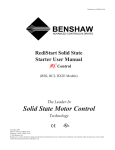
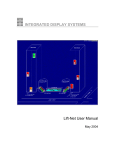
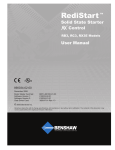






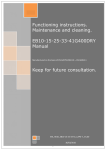

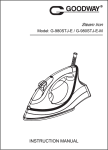
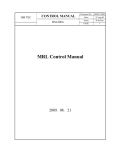

![EX MV MX3 User Manual [May16].vp](http://vs1.manualzilla.com/store/data/005646159_1-0d378a1c318c2dc00419aef6af60da73-150x150.png)
